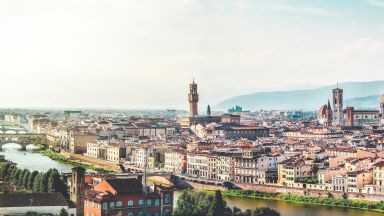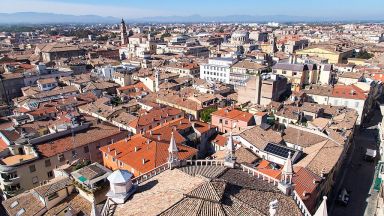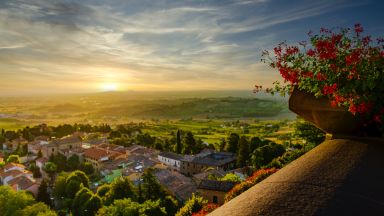Vicenza: The Complete Guide
Vicenza is a city in north-eastern Italy. It is in the Veneto region at the northern base of the Monte Berico, where it straddles the Bacchiglione River. Vicenza is approximately 60 kilometres (37 mi) west of Venice and 200 kilometres (120 mi) east of Milan. Vicenza is a thriving and cosmopolitan city, with a rich history and culture, and many museums, art galleries, piazzas, villas, churches and elegant Renaissance palazzi.
The great Renaissance architect Palladio left his mark all over this contented city (which has built much of its modern wealth on textiles and computer components). Indeed, Palladio didn’t stop within the city limits, spattering the hinterland with villas for the grand families of the Venetian Republic such as his renowned Teatro Olimpico (Olympic Theater), the “city of Palladio” has been listed as a UNESCO World Heritage Site since 1994.
Vicenza flourished as the Roman Vicentia. In 1404 it became part of the Venetian Republic. Testimony to the close ties between the lagoon city and Vicenza are the many Venetian Gothic mansions, not to mention the statues of the lion of St Mark and St Theodore that grace Piazza dei Signori.
Visiting Vicenza for the first time and wondering what are the top places to see in the city? In this complete guide, I share the best things to do in Vicenza on the first visit. Top help you plan your trip, I have also included an interactive map and practical tips for visiting!
This website uses affiliate links which earn a small commission at no additional cost to you.
History of Vicenza
Vicenza’s historical tapestry unfolds through successive colonisations by the Euganei and Venetians, shaping the foundations of the modern city. In the battle against Celtic tribes in the north, Vicenza emerged as a crucial strategic location, catching the attention of the Romans, who assimilated the city, known as “Vicetia,” into their empire in 157 BC. Bestowed with a Roman town charter in 49 BC, Vicenza became a pivotal hub on the Roman Decumanus Maximus, the primary route connecting Mediolanum (Milan) and Aquileia (Trieste). Today, Corso Palladio traces the path of this ancient Roman road.
Following the decline of the Roman Empire, Vicenza faced the tumultuous shifts in power dynamics and endured complete destruction by the Huns in 899. Emperor Otto III entrusted the city to the rule of bishops in 1001, providing the populace with an opportunity for growth. In 1164, Vicenza allied with Verona, Venice, and Padua in the Veronese League, later joining the Lombard League of Towns in 1167 against Emperor Frederick Barbarossa. While this newfound self-determination brought benefits, it also revived old rivalries, subjecting Vicenza to alternating influences from Padua and Verona. Eventually, Venice assumed control in 1404, incorporating Vicenza into the Veneto region.
The architectural legacy of Vicenza took a transformative turn in the 15th century, aligning with the broader history of Venice. A pivotal figure, Andrea Palladio, born in 1508, left an indelible mark on the city’s architectural landscape, pioneering classical design that resonated across Europe. His buildings and grand villas, still present in Vicenza and throughout Veneto, embody his enduring influence. Like the rest of Veneto, Vicenza experienced French rule in 1797 and later Austrian dominance before becoming part of the newly established Kingdom of Italy in 1866.
8 Best places to See in Vicenza
This complete guide to Vicenza not only tells you about the very best sights and tourist attractions for first-time visitors to the city but also provide insights into a few of our personal favorite things to do.
This is a practical guide to visiting the best places to see in Vicenza and is filled with tips and info that should answer all your questions!
Basilica Palladiana and Museo Palladiano

Location: Basilica Palladiana, Piazza dei Signori, Vicenza, Province of Vicenza, Italy | Hours: 10am-4pm Tue-Sun | Price: basilica adult/reduced €4/2, exhibitions €10-13 | Website | Distance: 0.90km
Visiting Basilica Palladiana and Museo Palladiano
Piazza dei Signori and Loggia del Capitaniato

Location: Piazza dei Signori, Piazza dei Signori, Vicenza, Province of Vicenza, Italy | Distance: 0.90km
Visiting Piazza dei Signori and Loggia del Capitaniato
Palazzo Leoni Montanari

Location: Palazzo Leoni Montanari, Contrà Santa Corona, Vicenza, Province of Vicenza, Italy | Hours: 10am-6pm Tue-Sun | Price: adult/reduced €5/3, or free with MuseumCard | Distance: 1.00km
Visiting Palazzo Leoni Montanari
Museo Naturalistico e Archeologico, Vicenza

Location: Museo Naturalistico e Archeologico di Santa Corona, Contrà Santa Corona, Vicenza, Province of Vicenza, Italy | Hours: All Week: 09.00 – 19.00 | Price: Single cumulative full ticket (Visit to the Naturalistic Archaeological Museum, Olympic Theater, Gallerie d'Italia, Diocesan Museum and Palladiummuseum): 10 € | Website | Distance: 1.00km
Visiting Museo Naturalistico e Archeologico, Vicenza
Teatro Olimpico

Location: Teatro Olimpico, Piazza Matteotti, Vicenza, Province of Vicenza, Italy | Hours: 9am-5pm Tue-Sun Sep-Jun, 10am-6pm Jul & Aug | Price: adult/reduced €11/8, or free with MuseumCard | Website | Distance: 1.20km
Visiting Teatro Olimpico
Palazzo Chiericati

Location: Palazzo Chiericati, Piazza Matteotti, Vicenza, Province of Vicenza, Italy | Hours: 9am-5pm Tue-Sun Sep-Jun, 10am-6pm Tue-Sun Jul & Aug | Price: adult/reduced €7/5 | Website | Distance: 1.20km
Visiting Palazzo Chiericati
Villa Valmarana (Ai Nani)

Location: Villa Valmarana ai Nani, Via dei Nani, Vicenza, Province of Vicenza, Italy | Hours: 10am-6pm Mar-Oct | Price: adult/reduced €10/6 | Website | Distance: 2.00km
Visiting Villa Valmarana (Ai Nani)
Villa La Rotonda

Location: Villa la Rotonda, Via della Rotonda, Vicenza, Province of Vicenza, Italy | Hours: villa 10am-noon & 3-6pm Wed & Sat mid-Mar–mid-Nov, gardens 10am-noon & 3-6pm Tue-Sun year-round | Price: adult/child villa & gardens €10/5, gardens €5/free | Distance: 2.50km
Visiting Villa La Rotonda
Best Time to Visit Vicenza
Visiting Vicenza in spring (March to May): The city is characterized by mild weather, blooming flowers, and vibrant greenery, offering an excellent opportunity to explore historic sites and engage in outdoor activities like hiking in the Berici Hills. The lower tourist numbers during this season create a more tranquil experience.
Visiting Vicenza in Summer (June to August): Vicenza experiences a high tourist season with warm and sunny weather, making it ideal for enjoying outdoor attractions, gardens, and piazzas. However, visitors should be prepared for larger crowds and higher prices, particularly in July and August.
Visiting Vicenza in Autumn or Fall (September to November): in Vicenza brings pleasant weather with comfortable temperatures, providing an excellent time for outdoor activities and savouring the city’s culinary delights. September, in particular, is favourable as the summer crowds start to dwindle, offering a warmer experience without the peak season prices.
Visiting Vicenza in Winter (December to February): in Vicenza has its own unique charm, offering a quieter and more intimate atmosphere. The historic centre looks enchanting with holiday lights, providing an opportunity to explore museums and indoor attractions at a leisurely pace. Additionally, Vicenza’s proximity to the Dolomites makes it a convenient base for winter sports enthusiasts.
Average Temperatures in Vicenza
- January 10°C 50°F 6
- February 13°C 55°F 10
- March 17°C 63°F 8
- April 21°C 70°F 10
- May 24°C 76°F 14
- June 30°C 87°F 11
- July 33°C 91°F 10
- August 31°C 88°F 11
- September 28°C 82°F 11
- October 23°C 73°F 11
- November 14°C 58°F 14
- December 10°C 50°F 8
How to get to Vicenza
Travelling to Vicenza by Air: The most convenient airport for reaching Vicenza is Venice Marco Polo Airport (VCE), offering excellent connectivity to major international airports. International travellers find it a preferred gateway. From the airport, convenient train or bus options are available for the 1.5 to 2-hour journey to Vicenza. Verona Airport (VRN), approximately 60 kilometres from Vicenza, is also a viable alternative.
Travelling to Vicenza by Train: Italy’s efficient and extensive railway network extends to Vicenza, served by the prominent Vicenza railway station along the Venice-Milan railway line. Seamless connections are available from cities such as Venice, Verona, Milan, and Florence. The train journey promises scenic views of the Italian countryside, enhancing the overall travel experience.
Travelling to Vicenza by Car: For those seeking flexibility and a desire to explore the surrounding areas at their own pace, renting a car proves to be an excellent choice. Vicenza enjoys a well-connected position within Italy’s highway system, with the A4 motorway providing convenient access to the city. However, parking in the city centre can be challenging, prompting the recommendation to park in designated areas and utilize public transportation within Vicenza.


